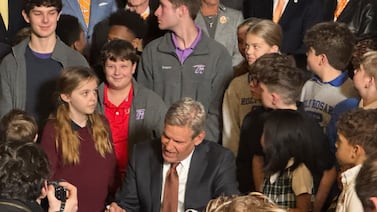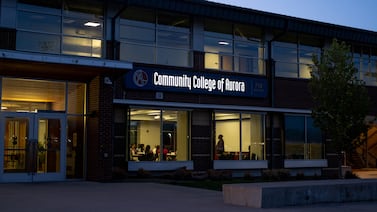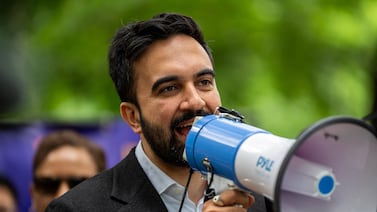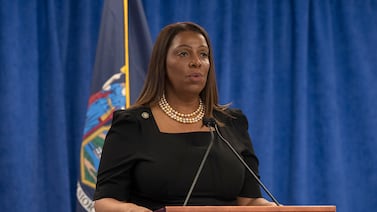One year into his tenure, Philadelphia Superintendent Tony Watlington’s methodical approach is focused less on grand oratory and more on incremental steps towards achieving his goal of creating “the fastest improving large urban district in the country.”
In an interview with Chalkbeat, Watlington highlighted an increase in student attendance of three percentage points, a bump in teacher attendance of seven percentage points, a 265-student decline in the number of dropouts, and a rosier fiscal outlook for the district since he took over last summer.
Watlington said he is now focused on improving student safety, repairing and upgrading school buildings, bolstering district communication with families, and launching a $70 million curriculum overhaul, starting this year with math.
“We’ve got the momentum, we’ve got the wind behind us now,” Watlington said. “We are going to accelerate reading and math performance this year now that attendance is up and the dropout rate is down … there’s an energy in our schools, there’s an energy in the bellies of our teachers and our principals.”
This coming school year, he’s pledged to increase the number of Safe Paths programs from seven to 13 schools, and update or replace 150 security cameras at schools that have them. On the academic front, he is planning to pilot a high-impact tutoring program at up to eight schools. As part of his five-year-strategic plan approved by the board, he also aims to build community support for a future year-round school pilot, which is presumptive mayor Cherelle Parker’s major education policy proposal.
Watlington is still facing serious challenges. Historic underfunding has left Philly schools in dire need of facility renovations and modernization. Student enrollment has declined, according to recent district data. Teacher vacancies are up. And gun violence is continuing to plague school communities: During the last school year, 199 students were shot in Philadelphia and 33 of those shootings were fatal, according to the district.
As the new school year approaches, some 85% of district schools have the new math curriculum materials they are scheduled to begin teaching this year, Watlington said. Though the district hired 700 new teachers and counselors for the upcoming year, the district’s teacher workforce is only staffed at 95%, he said. That means there could be more than 400 vacancies among its approximately 9,000 teacher positions that still need to be filled before the school year starts Sept. 5.
“We’ve still got work to do,” Watlington said of teacher hiring. He said the district has had to look outside of Pennsylvania to “expand our recruitment footprint, speed up the onboarding time, so we can get people hired quicker.”
Watlington’s low-key approach has been markedly different from Philadelphia school leaders in the past like Paul Vallas, who declared the need for a dramatic turnaround and immediately instituted new policies and initiatives upon arriving in the city. In temperament and leadership style, Watlington is more like his immediate predecessor, William Hite.
In his first year, Hite had to deal with significant state budget cuts and presided over wrenching, permanent school closures, which sparked community anger that led to saving some of the schools slated to be shuttered.
Watlington has had billions in federal COVID aid to help him get through his inaugural year at the district — although a “fiscal cliff” is looming for 2024-25, when that aid ends.
Watlington sat down with Chalkbeat on Wednesday to reflect on his first year in office and discuss his goals for the upcoming school year and beyond. This interview has been lightly edited for length and clarity.
What are the biggest challenges you’ve faced during your tenure?
One of the biggest challenges continues to be the facilities in our district. We’re having to work really hard … to basically right the wrongs of systemic underfunding over a long period of time.
We’re not putting our heads in the sand, we’re not hiding in the corner complaining. We’re just stepping up to the plate.
[The district operations team] has been working hard on developing a master swing space plan so that when we have another school closure [due to damaged asbestos] — not if, but when we have another school closure in the school district, we can get our kids back in in-person learning much quicker than we did at Frankford High School.
We’ve been working throughout the summer to start planning for a project team that will launch this fall. That project team will help us identify how to, within our existing resources, build our long-range plan to bring all of our schools up to 21st century standards. It won’t happen overnight, but this year, we’re gonna tackle those tough issues with a lot of internal and external people.
What is your number one priority for the district this year?
We’re going to partner with our parents and really ramp up and improve our communication and parent engagement efforts so that we can improve reading and math performance.
Bottom line, our kids need to be able to do reading and math on grade level. It is super critically important. And we know we can make significant improvements. We have to make good investments. We are focused on what the research tells us and we all have to wrap our arms around our young people together as a city and say we must and we can do better.
What do you think success looks like for the Philadelphia school district?
Success for the school district is when we increase the third grade on grade level reading performance. We’ve got to get more of our young people [access to] algebra in middle school because it’s a gateway to higher level math in high school. And when they get to high school, we need our kids to graduate in four years, prepared to go into building trades, the community college, or a four-year institution where they don’t have to take remedial courses. That’s how we’re defining success.
How do you ensure you’re being a leader rather than a crisis manager?
The number one way … we keep our district from being a district that operates in crisis [is] we have to have a roadmap, a strategic plan, because … it tells us clearly: What specific priorities and strategies are we going to align all of our resources to?
The strategic plan is designed in such a way that we don’t do everything at one time. … We won’t do a haphazard job. … One of the reasons why we’re not implementing the year-round schools [model] this year is because we’re going to take this year to build parent and community interest, and we’re going to take the time to build the best model for Philadelphia. … We’ll launch that in 24-25 versus this school year.
[Another] way we stay out of crisis mode is we constantly take a look at our budget and our data to see what’s working, what’s not working. It’s simple: this strategic plan will help us to put more resources into where we’re getting a return on investment, and things that aren’t working, quite frankly, we’re going to stop doing them. That’s why we’re not continuing with certain curriculum programs in our school district. We’re not getting the return on investment.
Carly Sitrin is the bureau chief for Chalkbeat Philadelphia. Contact Carly at csitrin@chalkbeat.org.
Dale Mezzacappa is a senior writer for Chalkbeat Philadelphia, where she covers K-12 schools and early childhood education in Philadelphia. Contact Dale at dmezzacappa@chalkbeat.org.






